Good family recipes can travel through time and space. What sets them apart is not their being more or less elaborate or “gourmet”; rather, a recognizable geniality, a revelation of taste, texture and ingredients. The culinary embodiment of what we call a very good idea.
This salsa verde is one of those recipes.
Back in the ‘60s, Venice’s industrial development was brimming with promises.
Many families in port cities across Italy, like Genova, saw an opportunity and quickly moved here. With them came little children, hopes, and home cooking repertoires alien to the classic Venetian fare.
That's how my Ligurian grandparents-in-law ended up in Mestre1, and why we couldn’t live without their sensational salsa verde.
Despite what people say about the Genoveses (stingy af, and yes it is true), their cuisine is full of lush ingredients: fruity olive oil from the surrounding hills, pine nuts long and creamy white, fat bunches of herbs, ubiquitous eggs – and a focaccia so rich it leaves pools of oil in the cappuccino they dip it into for breakfast.
Encapsulating the best traits of Riviera cooking, our green sauce is a beautiful bright-green spread with a thick, rich consistency and a flavour that’s tangy, savoury and fresh. Granted, it’s Ligurian, but we eat it the Venetian way: like a cicchetto, dolloped on top of a crostino or scooped into the hollow of a boiled egg white.
Yum.
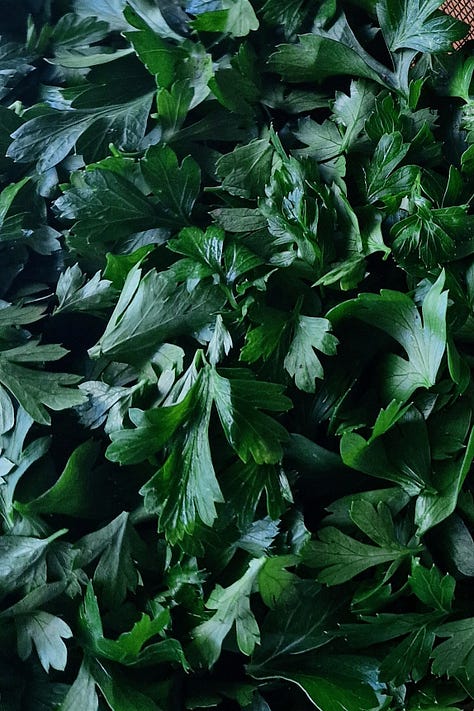
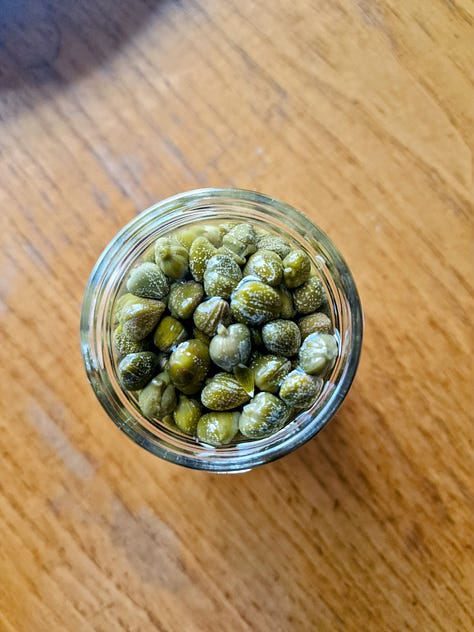
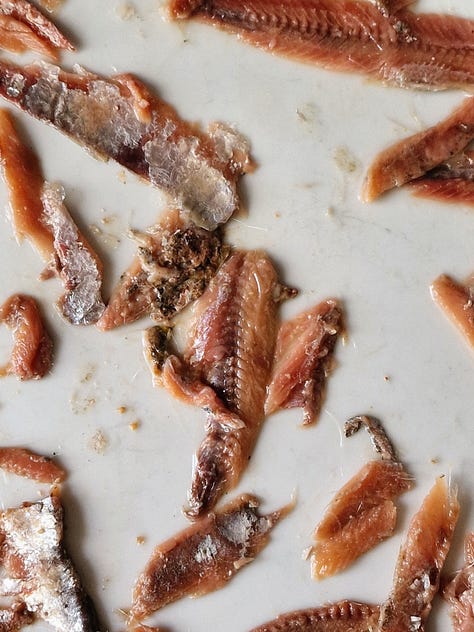
THE SECRET: Balancing flavours and textures
To make Ligurian salsa verde you’ll need three groups of ingredients, each one playing a key role:
Italian parsley for a fresh herby base
Pine nuts, olive oil, breadcrumbs and eggs for richness and body
Capers, anchovies*, vinegar and garlic for umami and character
The single most important secret lies in balancing the textures and flavours of all the components involved. Which, in turn, depends entirely on: choosing, prepping and dosing ingredients correctly; using the right equipment, if available; and, ultimately, adjusting the salsa to your own taste.
It tastes big, it tastes bold. It feels smooth, it feels lush. But if you’ve never tried it before how do you know what to look for?
The notes below give you all the necessary pointers to pull it off with confidence. And for any doubts or questions, just drop me a comment.
All about the ingredients
Flat-Leaf Parsley
You want to get the freshest, youngest parsley you can find and use only the leaves, not the stems2 (see image above). Young leaves are sweet and tender, resulting in a smoother, more pleasantly flavoured salsa. If you must use older parsley, make the salsa and refrigerate overnight. The oil will soften the fibres and mellow the bitter notes.
Extra Virgin Olive Oil
Choose a mild and fruity evo oil. You'll be using a lot of it, so quality will have a big impact on the overall taste. Avoid oils that are bitter or overpowering. Have you ever tried evo oil from taggiasche olives? It’s a typical variety of the Italian Riviera.Pine nuts
Pine nuts are a signature ingredient of Ligurian cuisine, but can be pricey and difficult to source. While I haven't tested the recipe with other nuts, mild options like cashews or Brazils could be worth a try. Fun fact: many commercial pestos in Italy are actually made with cashews, presumably because they’re cheaper. This substitution isn't always well-received by Italians (more like never).
Capers
Capers should be brined or preserved in vinegar. They need to be roughly squeezed before blending, but not rinsed, as the residual liquid contributes to seasoning the salsa. Capers in olive oil are milder in taste, so you’ll need 0.5 more than the quantity in the recipe (for example, 3 tbsp instead of 2).Anchovies
Anchovies should be salted. If not available, those packed in oil work fine, but you may need to adjust the salt accordingly. While anchovies are a traditional component, omitting them won't greatly compromise the taste – I always make my salsa without them, and it's 👌Garlic
A medium clove yields a mild result, two medium cloves intensify the aroma without overpowering. If all you got is old, smelly garlic, leave it out – it’ll ruin the whole batch.
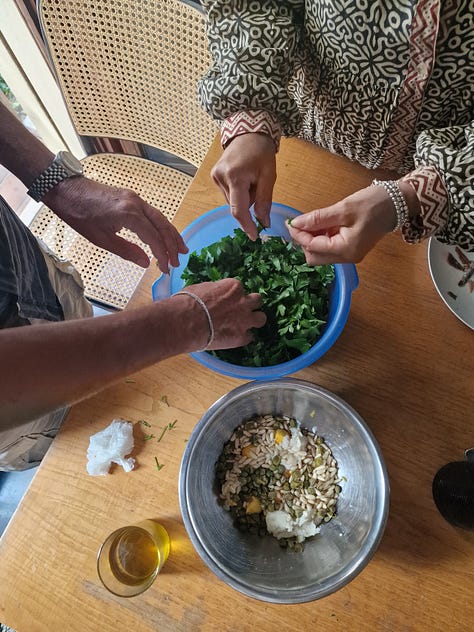
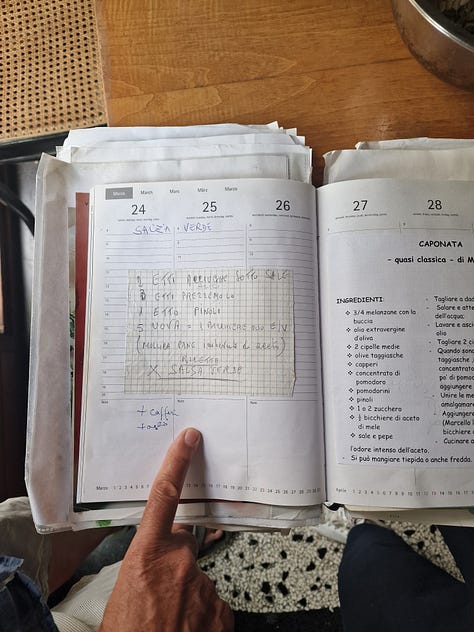
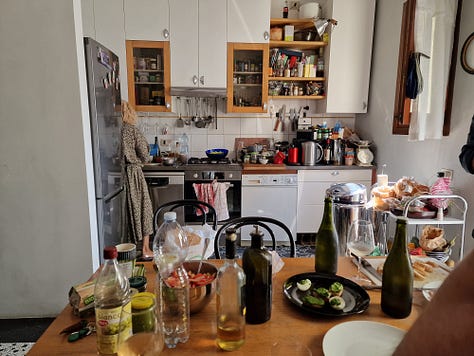
Preparation, equipment, seasoning, troubleshooting
Blending
Blend slowly and use steel equipment to avoid overheating. A steel bowl and a stick blender with a steel attachment will come in handy. With a jug blender the salsa will sit on top of the hot engine while whizzing (not ideal), but it’s ok if that’s all you’ve got.
Seasoning
If you’re skipping the salted anchovies and subbing ingredients around, you will need to adjust the seasoning. Blend first and then adjust. This will give you more control and help you avoid compromising the whole batch. Play around with salt and vinegar: proceed pinch by pinch and teaspoon by teaspoon until you can identify all of the ingredients but none is overpowering (it’s ok for the vinegar to be a bit arrogant at first, it mellows with time). Your own taste plays a part here, so feel free to experiment accordingly. Like more garlic? That’s totally fine.Troubleshooting
Refrigerating overnight will help mellow the flavours (especially the vinegar), and cool down the salsa after blending, rendering a nice thick consistency. If you can’t wait a whole night, cover with cling film and wait at least 2 hours.
RECIPE: Ligurian Salza Verde
Make this brilliant sauce and invite friends and family over for cicchetti and wine :) Spread it on top of crostini and pair it with a crisp glass of white wine. Manage your time wisely: plucking leaves requires patience (put on a good movie), and the salsa is at its best after a night's rest in the fridge.
Yield: about 650-850g, depending on whether you’re adding anchovies or not. Keeps for up to 5 days in the fridge.
US measurements in the footnotes.3
Ingredients
Eggs: 5, hard-boiled
White bread: 70g crust removed (about 120g roll)
White wine vinegar: 180ml plus a few teaspoons if needed
Brined capers: 2 tablespoons, roughly squeezed
Salted anchovies: 200g, rinsed (optional)
Flat-leaf parsley leaves: 120g, from a large bunch, approx 350g to 450g
Pine nuts: 100g
Garlic: 1 medium clove, finely chopped
Evo oil: 170ml plus 50ml for storing
Black pepper: 2-3 twists
Salt: to taste
To serve: crostini, slices of baguette or similar
Utensils
Large bowl, preferably steel
Blender, preferably hand-held and with a steel attachment
2 clean glass jars (200-300 g each)
Method
Eggs: Peel and halve the boiled eggs. Separate the yolks from the whites. Do a clean job4 as you’ll need the whites for serving the salsa.
Bread: Soak the bread in vinegar until it's squishy and has absorbed almost all the liquid.
Parsley: Pluck the parsley leaves as illustrated. Wash and pat dry with kitchen paper or a clean cloth.
Capers & Anchovies: Squeeze the brined capers. If you're using anchovies, scrape the salt crust, rinse well under running water and with your hands remove the skin, spine and other bones.
Blending: Squeeze the bread well with both hands and add to the bowl alongside the yolks, parsley, capers and anchovies. Combine with the pine nuts, garlic, and half of the oil. Season with pepper, a pinch of salt, and mix. Slowly blend everything while adding the remaining oil in two or three times, until you achieve a thick, creamy, bright green paste.
Taste Test: Sample the salsa and adjust the salt and vinegar if needed.
Cooling: If the salsa feels warm and liquidy, cover with cling film and place in the fridge. Allow it to cool and thicken for about 2-3 hours or leave it overnight.
Serving: Spoon the cool salsa into the hollows of the reserved egg whites and onto a few crostini or bread slices. Serve on a platter, with dry white wine.
Storing: Transfer the salsa into 2 clean* glass jars (jam jars will do). Tap to remove air bubbles. Before sealing, clean the rim with a paper towel and cover with a thick layer of olive oil. The oil will prevent oxidation and preserve the taste. Go through one jar at a time and top up the layer each time you eat some.
*You’re not preserving the salsa for months, so you won’t need to sterilize the jars, but make sure they’re clean and hygienic.
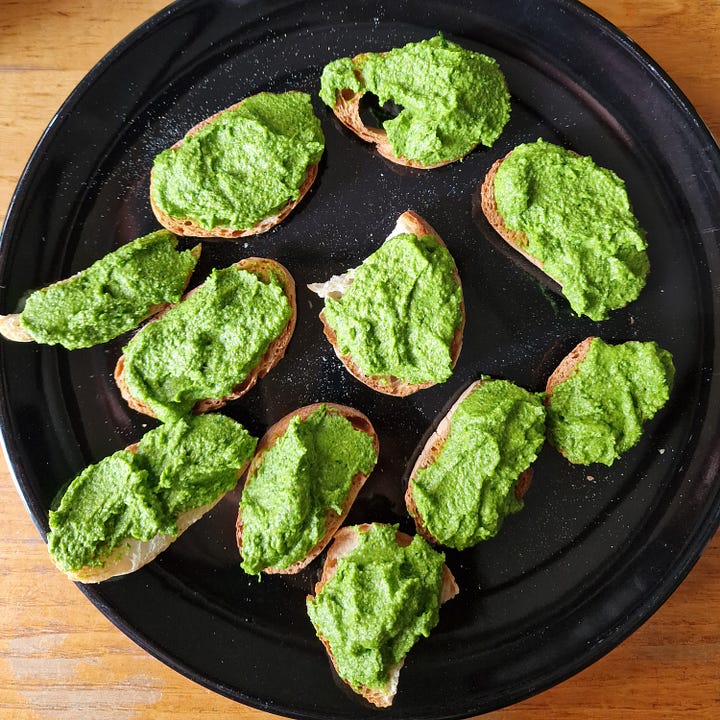
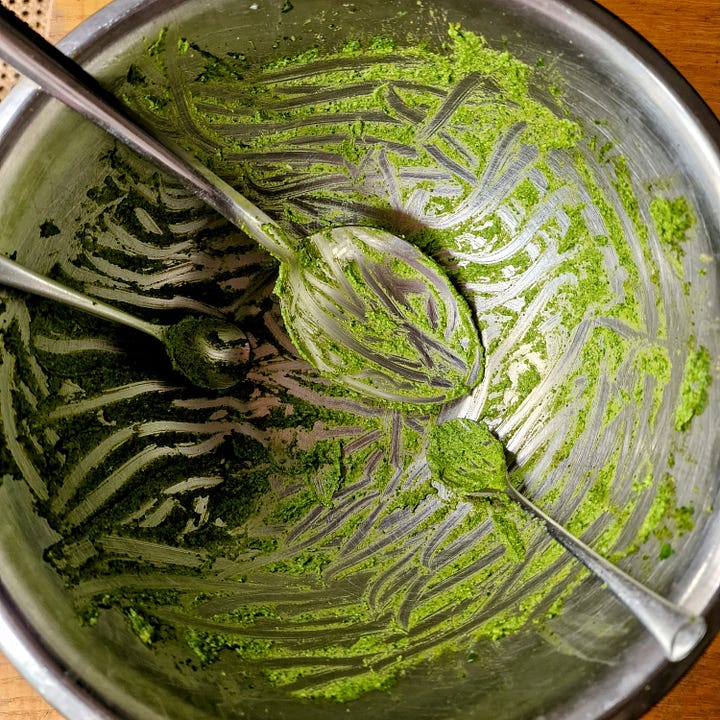

What’s your take on the green sauce? Love it or loathe it? Ever tried the Ligurian variant?
Until next time,
Sinù xx
Mestre and Marghera are the mainland neighborhoods of Venice, located just off the Liberty Bridge that connects the islands to the rest of Italy. Most Venetians who are priced out of proper Venice move to these areas.
What to do with the discarded parsley stems: freeze for later use in stocks to add sweetness and freshness. Lovely in spring broths.
Ingredients in US measurements:
Eggs: 5, hard-boiled
White bread: 3 slices of standard white bread with the crusts removed (about 2.5 oz)
White wine vinegar: ¾ cup, plus a few teaspoons if needed
Brined capers: 2 tablespoons, roughly squeezed
Salted anchovies: 7 oz, rinsed (optional)
Flat-leaf parsley leaves: about 4 1/4 packed cups (from a 12-16 oz bunch)
Pine nuts: ¾ cup
Garlic: 1 medium clove, finely chopped
Extra virgin olive oil: ¾ cup, plus about 3.5 tablespoons for storing
Black pepper: 2-3 twists
Salt: to taste
To serve: crostini, slices of baguette, or similar
How to neatly peel boiled eggs:
Add the eggs to boiling water, not cold.
Once the eggs are done boiling, pour out the hot water and gently shake the pot to slightly crack the eggshells.
Place the pot under cold, running tap water for about 20 seconds. Turn off the tap and let the eggs sit in the cold water for an additional minute.
Start peeling, and the shells should come off more easily.




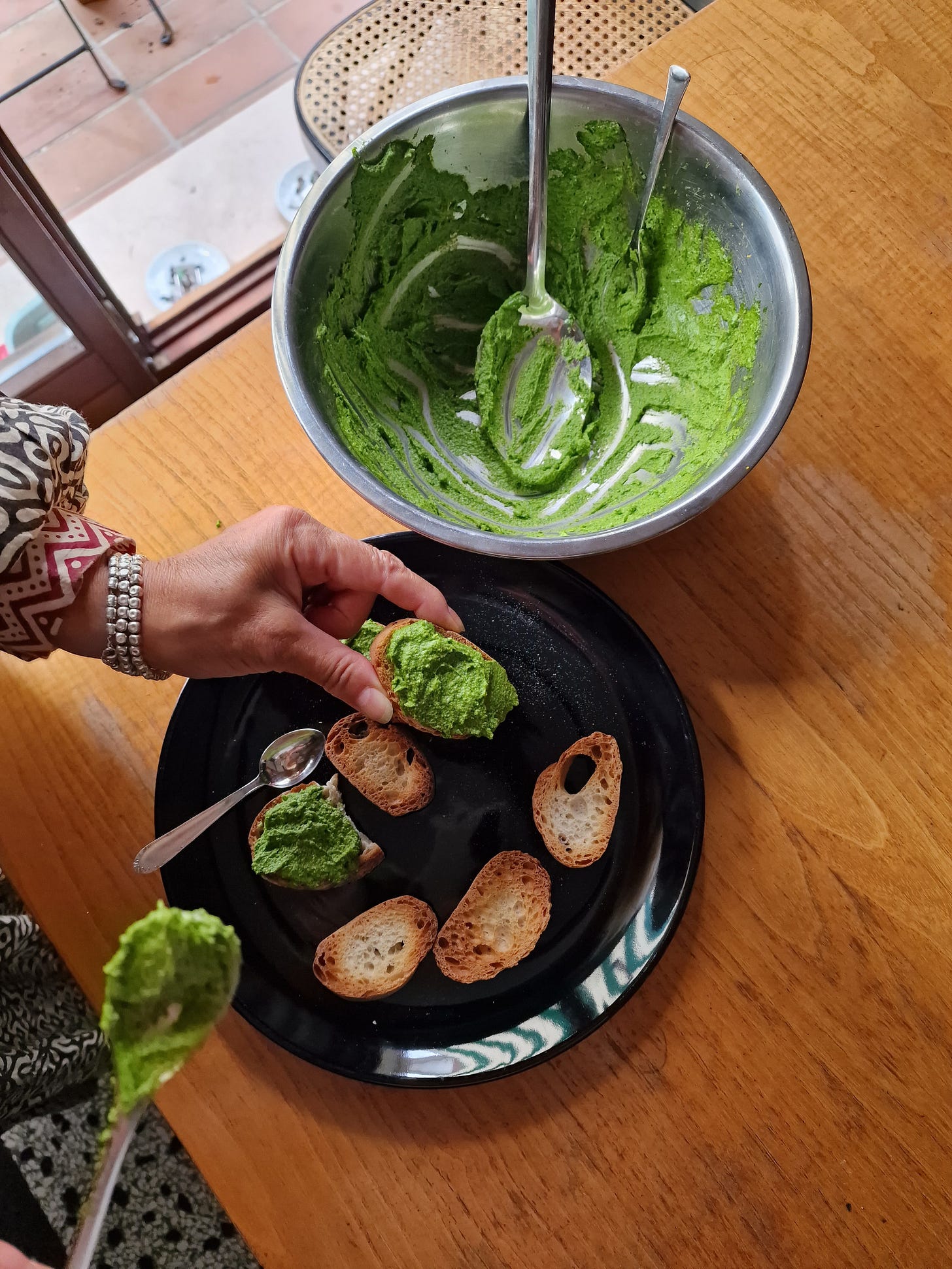

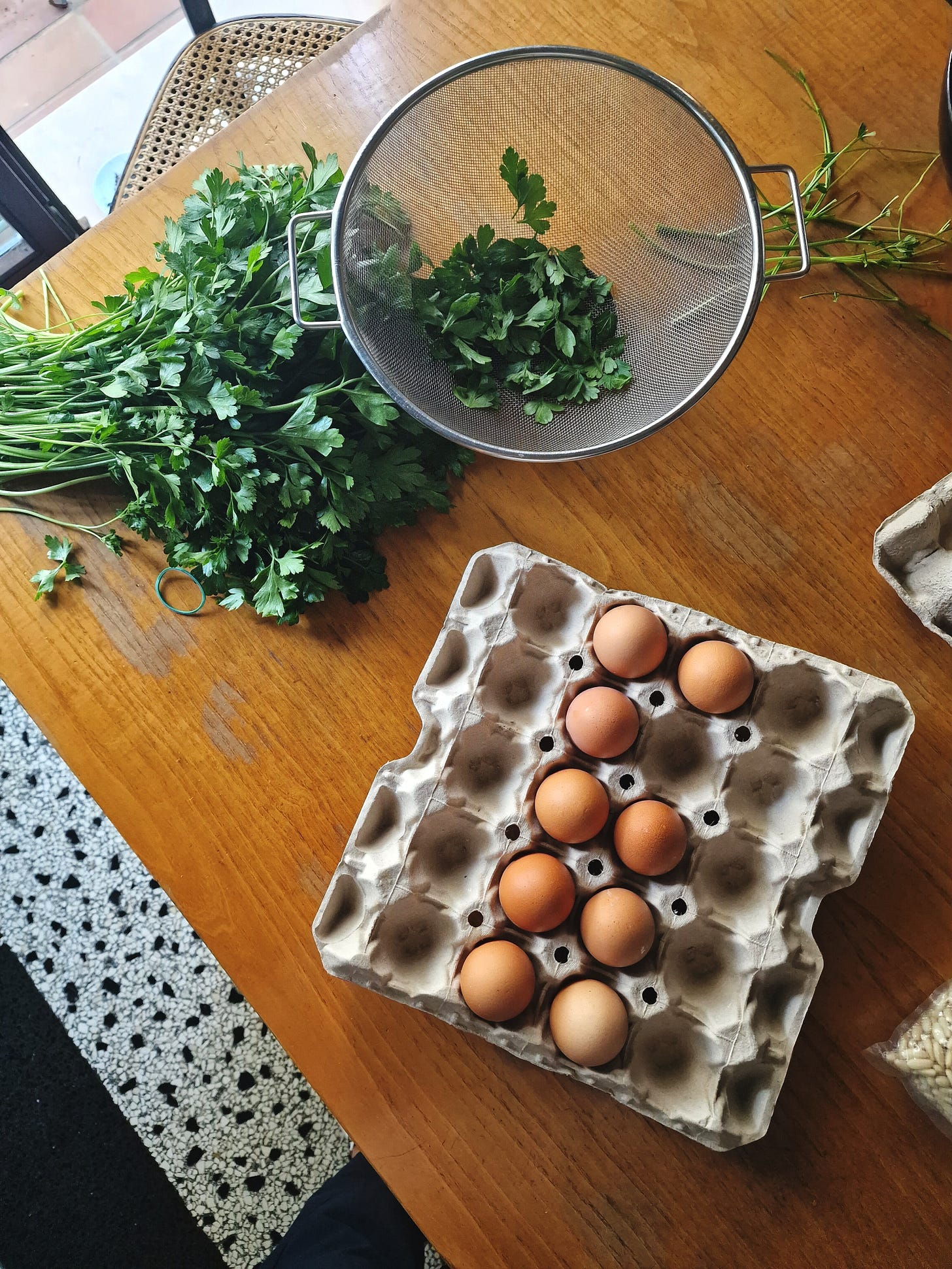
A wonderful and inspiring newsletter. Thanks so much!
I need to make this! It looks and sounds so delicious.